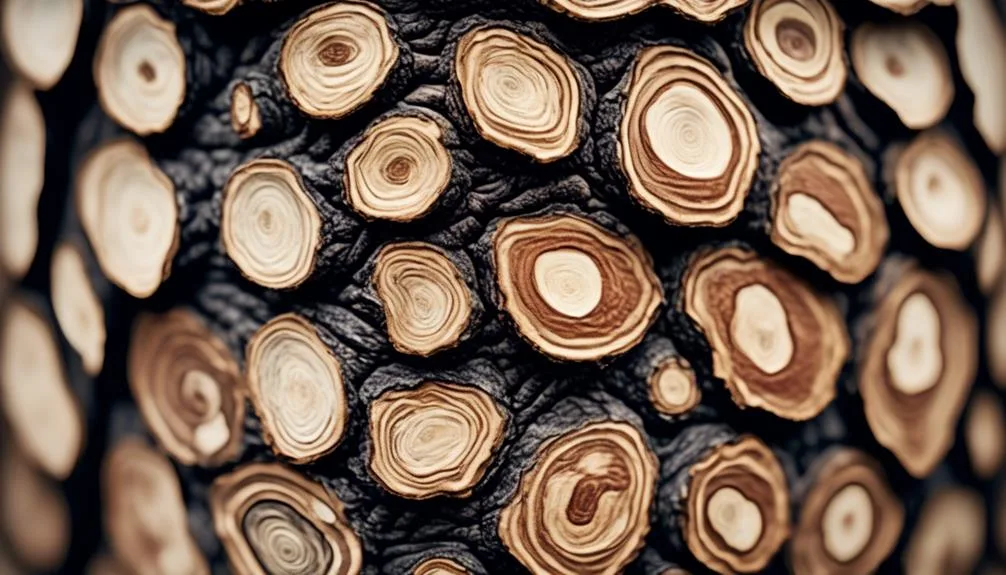Have you ever wondered about the unique bark patterns on dogwood trees?
Their striking contrast to other tree barks is not just for looks.
The reasons behind these patterns involve a mix of biological adaptation, environmental influence, and evolutionary significance.
Understanding the story behind dogwood tree bark reveals a world of natural wonders that goes beyond mere aesthetics.
Dogwood Tree Bark Patterns
Examining the intricate patterns of dogwood tree bark reveals a mesmerizing display of natural artistry, evoking a sense of wonder and appreciation for the diversity of the natural world.
The bark texture of dogwood trees is particularly fascinating due to its unique patterns that change with the seasons. In the spring and summer, the bark is smooth and has a distinct mottled appearance, resembling a work of art painted by nature.
As autumn arrives, the bark undergoes a transformation, developing a rougher texture and deeper grooves, adding a new dimension to the tree's visual appeal. These seasonal changes in bark texture not only contribute to the tree's aesthetic beauty but also serve as a testament to the resilience and adaptability of the dogwood in different environmental conditions.
Biological Purpose of Bark Patterns
As you observe the mesmerizing display of natural artistry in the bark patterns of dogwood trees, it becomes evident that these intricate designs serve a crucial biological purpose within the tree's ecosystem.
- Camouflage: The unique patterns on the bark of dogwood trees help them blend into their surroundings, providing camouflage from predators and allowing them to evade detection.
- Communication: Bark patterns can also serve as a form of communication within the tree's ecosystem. Different patterns may attract specific insects or birds, aiding in pollination and seed dispersal.
- Protection: The variations in bark patterns can help protect the tree from environmental stressors, such as temperature fluctuations and physical damage, by providing insulation and structural support.
Environmental Adaptations
What role do the bark patterns of dogwood trees play in helping them adapt to their specific environmental conditions? Dogwood trees have developed unique adaptation mechanisms in response to their environmental challenges, including climate change impacts. The bark patterns serve as a protective layer, shielding the tree from extreme temperatures, moisture loss, and potential damage. This intricate bark not only provides insulation but also helps regulate the tree's temperature and moisture levels. The patterns also deter pests and fungal infections, contributing to the tree's overall health and resilience. Here's a visual representation of the various environmental adaptations of dogwood trees:
| Adaptation Mechanisms | Climate Change Impacts |
|---|---|
| Insulating bark | Temperature extremes |
| Moisture regulation | Increased drought |
| Pest deterrent | Fungal infections |
| Protective layer | Environmental stress |
| Resilience booster | Adverse conditions |
Role of Bark Patterns in Protection
The unique bark patterns of dogwood trees not only serve as a shield against environmental challenges but also play a crucial role in protecting the tree from extreme temperatures and potential damage.
- Bark Camouflage: The mottled patterns on the dogwood tree's bark help it blend into its surroundings, making it harder for predators to spot.
- Temperature Regulation: The patterned bark helps regulate the tree's temperature by reducing the impact of direct sunlight and insulating the tree from harsh weather conditions.
- Predator Defense: The distinct bark patterns may deter certain herbivores and insects, providing a layer of defense against potential threats to the tree's health.
Evolutionary Significance
Evolving over time, the intricate bark patterns of dogwood trees have played a pivotal role in their survival and adaptation to diverse environmental conditions. The evolutionary development of these patterns is a result of genetic inheritance, allowing the trees to thrive in various habitats. The unique bark patterns provide a form of camouflage, helping the trees blend into their surroundings and evade predators. Additionally, the patterns aid in thermoregulation, protecting the trees from extreme temperatures and minimizing water loss. The evolution of these bark patterns showcases nature's remarkable ability to fine-tune traits for the survival of species. Below is a table summarizing the evolutionary significance of dogwood tree bark patterns.
| Evolutionary Significance |
|---|
| Genetic Inheritance |
| Camouflage |
| Thermoregulation |
Conclusion
In the intricate patterns of a dogwood tree's bark, we find a remarkable adaptation to its environment, showcasing nature's resilience and ingenuity. These patterns not only serve a biological purpose but also offer valuable insights into the adaptability of plants in the natural world.
What other hidden wonders await our discovery in the intricate designs of the natural world?

My interest in trees started when I first saw the giant sequoias in Yosemite.
I was a teenager then, and I remember thinking, “I need to learn more about this.”
That moment stuck with me.
A few years later, I went on to study forestry at Michigan Tech.
Since graduating, I’ve worked in a mix of hands-on tree care and community education.
I’ve spent over ten years helping people understand how to plant, maintain, and protect the trees in their neighborhoods.
I don’t see trees as just part of the landscape.
They are living things that make a real difference in our daily lives.
